|
|
|
|
The CAVE environment |
Head Mounted Display |
Artificial Nature and Natural Artifice
Philippe Codognet
Université Paris 6
LIP6, case 169
4, Place Jussieu, 75005 PARIS, France
Virtual Reality (VR) is currently coming out of the research labs to reach mainstream audience. After moving from the textual computer to the flatland monitor in the previous decade, the 90’s has seen the emergence of Virtual Reality as the next technological frontier. Sooner or later all computer interactions will be in three dimensions, even if always through the classical Albertian window of the screen rather than with complex visual or haptic devices. The WWW will also be affected by this revolution, and we will soon change our way of browsing the Internet from surfing flat HTML pages to diving into 3D virtual worlds, that is, virtual spaces where digital communities could meet and experiment new communication media.
I. Virtual Artworks
Some experiments have been already done with VR immersive art installations. These works has been in general realised with new technologies such as CAVE environments (created by the EVL group at university of Illinois 1992) or Head Mounted Displays (HMD, NASA 1984), following pioneering ideas by Ivan Sutherland (1968) and the forgotten pionneer/engineer H. Mortt (1960).
|
|
|
|
The CAVE environment |
Head Mounted Display |
Let us consider some well-known art works using such devices :

Perceptual Arena by Ulrike Gabriel, Cannon ARTLAB 93
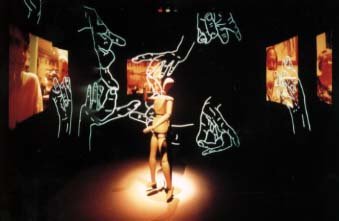
Configuring the CAVE by J. Shaw/A. Hegedus/B. Linderman - ICC Museum, 97

Osmose by Char Davies, Barbican Gallery 1997
|
|
|
|
Web VRML version |
Immersive 3D installation |
Icare by Ivan Chabaneau, CICV 97
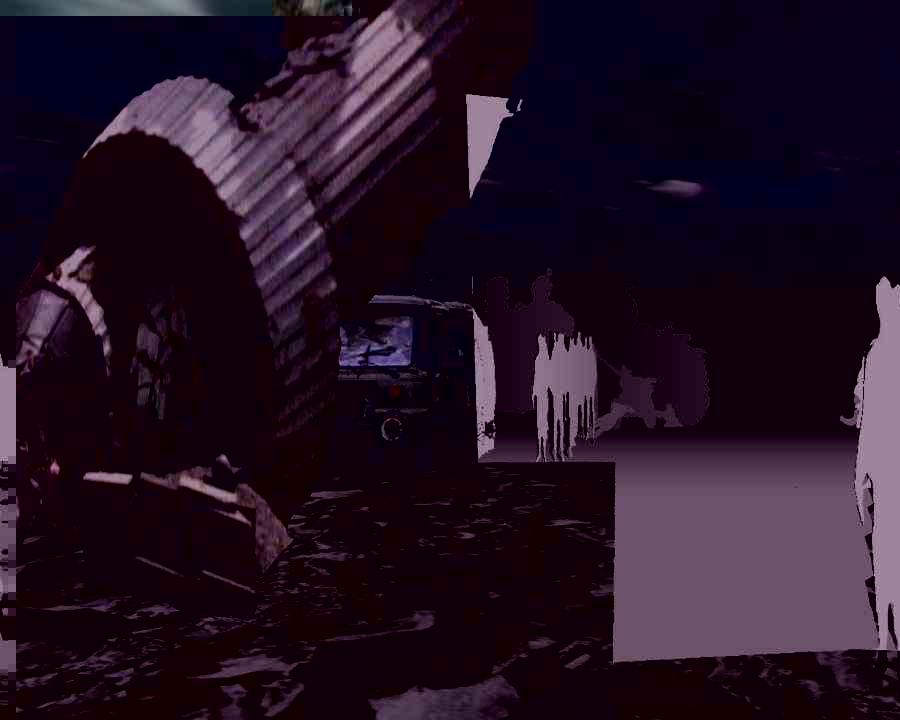
World Skin by Maurice Benayoun, Ars Electronica, Linz 1998
Close to these apparatuses is the use of circular projection walls surrounding the spectator for creating an interactive virtual environment (VE), introduced by the artworks of Jeffrey Shaw :
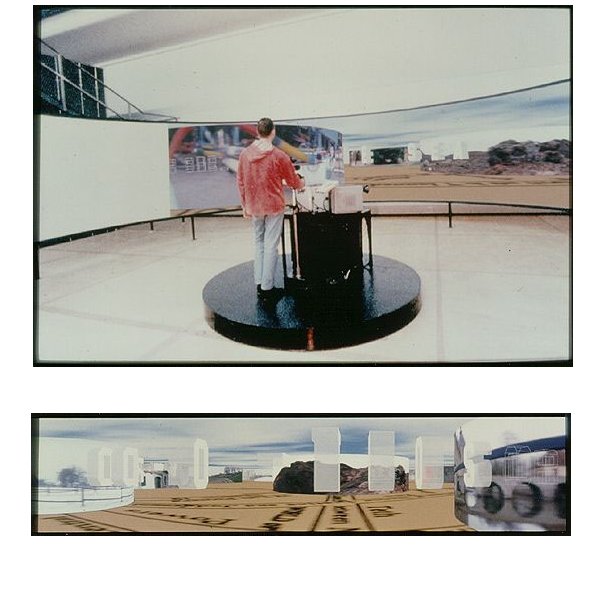
‘Space - a user’s manual’ by Jeffrey Shaw, 1995
(a richer version of his famous ‘legible city’ created several years before)
Agnes Hegedus’s ‘Memory Theatre’ (ZKM, 1997) also uses a similar circular projection wall in order to recreate an immersive environment.
A cheaper version of virtuality is feasible within the flat monitors of standard computers : 3D worlds rendered with the VRML description language (Virtual Reality Modeling Language) and displayed with an adequate browser. This medium has already been used in some artworks such as suspension by Jordan Crandall and Marek Walczak (Documenta X, 1997) or the web version of Icare by Chabaneau.
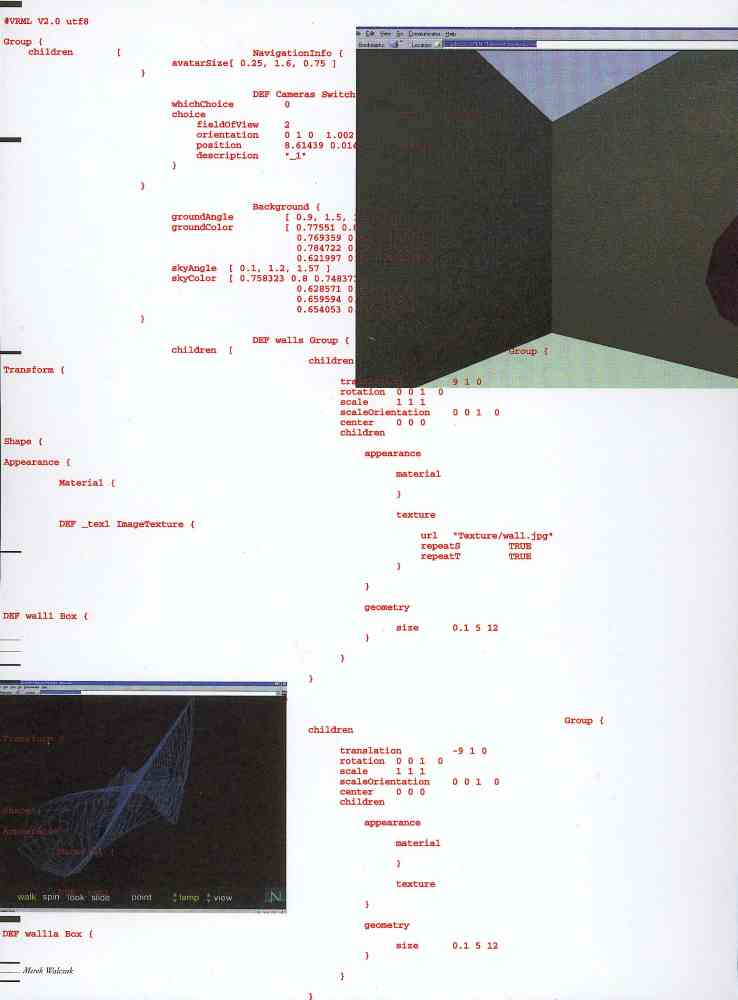
Suspension by Jordan Crandall and Marek Walczak, Documenta X, 1997
In a scientific context, this technology has been used for creating modern Wunderkamern, e.g. for the depiction of the human body (and its inside, cf. the virtual human project) or for space exploration (e.g. ‘live’ 3D reconstruction of Mars by NASA / SGI) : Temples of the body and temples of the cosmos as in the Renaissance, cf. Martin Kemp’s article in Picturing Knowledge, edited by B. Baigrie, Toronto University Press, 1997 ...
One should nevertheless distinguish between the two apparatus mentioned at the beginning of this talk : the CAVE and the HMD. They seem to be used for different purposes in artworks. CAVE or CAVE-like environments are used to represent virtual (but Euclidean) spaces (e.g. Space - a user’s manual by Jeffrey Shaw), whereas works using HMD are more oriented towards abstraction (e.g. Ulrike Gabriel’s perceptual arena).
Is there here a dichotomy between a perspectivist outside space and an inner abstract self ?
II. The prehistory of Virtual Reality
Let us investigate the historical background of these apparatuses, for instance in the Renaissance :
|
|
|
|
Moving painted walls |
Projected images |
Two pages from engineer Giovanni Fontana’s castellum umbrarum, 1420
It describes a room with walls composed of folded translucent parchments lighted from behind, creating therefore an environment of moving images. He also designed some kind of magic lantern to project on walls life-size images of devils or beasts. The use of projected images on walls was later detailed by one of the major figure of baroque humanism, the Jesuit father Athanasius Kircher " master of a thousand arts " in Ars magna luce et umbrae 1646.
2) trompe l’œil frescoes in venetian, florentine or roman villas in the Renaissance : see for instance the"perspective room" by Peruzzi in the Villa Farnesina (Roma, 1510), where a fictitious landscape is painted on the wall of the main room in place of some windows, as an acme of perspectivist and illusionistic virtuosity.
Leonardo himself also worked on such schemes and one can find in one codex a drawing describing how to illusionary project a painting on a cubic volume in order to recreate a non-distorded image, a device much later put at use in an electronic manner by D. Sandin and T. De Fanti, the creators of the CAVE immersive 3D environments.
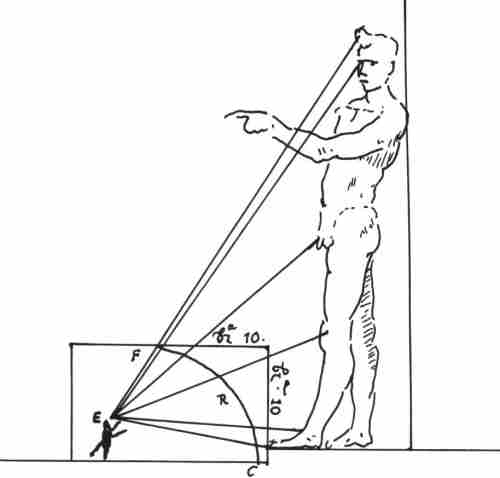
drawing by Leonardo da Vinci (sketched by Martin Kemp in The Science of Art, 1990)
Hence, immersive environments creating a fictitious or illusory ‘virtual’ space by projecting images onto the walls of a closed room have been investigated for quite a long time, though new technologies give a new impetus because of the ease of creation and of the " realism " of the constructed space. Another point, that we will develop much more deeply later is the interactivity introduced by the possibility of moving within the environment.
The second type of apparatus is the HMD, where the user/spectator is totally cut from the real world and immersed within the fictitious space that in projected on two small monitors in front of the eyes. This device became the allegorical emblem of virtual reality, the symbol of high-tech art for the general public. The idea that the user/spectator is immersed within himself is certainly not alien to the success of this contemporary icon.
Let us rewind the tape of history and look back at the tradition of this concept.
Leibniz is a key philosopher to understand contemporary changes in our society. Not only is he credited for the invention of binary notation (imago creationis, that is, at the image of the Creation) and the birth of symbolic logic, which are both at the conceptual basis of modern computers, but his baroque philosophy also prefigured many aspects of post-modern ideas.
Gilles Deleuze in his study of Leibniz (Le pli, Leibniz et le baroque 1988) considered that the closed room, without any windows, is the best visualisation of the Leibnizian concept of monad (Monadology 1714), and is best exemplified in baroque art by the studiolo of Francesco I da Medici in the Palazzo Vecchio (Florence 1570-72). A monad is an entity, a soul (‘a subject as metaphysical point’ would say Deleuze) " without doors nor windows " and containing the whole world ‘folded’ within itself. Similarly the studiolo contained the whole world (metaphorically) painted on its walls. Another philosopher used the concept of monad one century before Leibniz : Giordano Bruno (de triplici minimo et mensura 1591). Indeed, Bruno’s burning stake still sheds his light on the XVIIth century philosophy (to use the words of Michel Serres). For Bruno, the metaphor of the philosophical quest for knowledge is best expressed by the myth of Acteon (De gli eroici furori 1585). Acteon, having seen Diana nude during her bath, is chased by her dogs and made blind. According to Bruno, the philosopher has also to become blind and close his eyes to find the ultimate truth within himself, cut out from the bodily sensations.
A direct representation of those ideas can be found in Ripa’s Iconologia, where metaphysics is represented as a blindfolded allegory :
![]()
(here in Jean Baudoin’s french edition of 1644).
A similar picture is associated to the concept of ‘soul’ in the work the Czech humanist Comenius (Jan Amos Komensky) in his Orbis sensualium pictus quadrilinguis (1658), " the painting and nomenclature of all the main things in the world and the main actions in life ", actually a pictorial dictionary. Images are "the icons of all visible things in the world, to which, by appropriate means one could also reduce invisible things ". Soul is actually depicted as a veiled head.
Could this be a plausible background, a cultural archetype, for the success of the HMD imagery as the mean to dive into a virtual world within oneself ?
Moreover, does this HMD imagery suggest a deep melancholy, a sour regret, for the loss of metaphysics in our modern world ?
III. The spectator’s point of view
An important characteristic of VE is the possibility for the spectator to interactively move within such spaces, and perceive the virtual world as through a subjective camera. In some sense the spectator becomes an actor, although it can usually do little than just wander around. This moving, first-person perspective is for some artists an answer to the critic of modern perspectivism, mimesis and ‘realism’ of their works (cf. the paper of Manuela de Barros at this conference).
An important point to note here is that we are changing from the cartographic paradigm to the ichnographic paradigm. The idea of the " cartographic eye in art " appeared recently to reconsider modern art up to the 60’s, see the book Christine Buci-Glucksmann (éditions Galilée, 1996) and also the ‘Mapping’ exhibition at the MOMA, New York, 1994). This concept is especially relevant for the 60’s in America (Jasper Johns, Robert Morris, Robert Smithson).
But with VE we are moving away from the metaphor of the map to that of the path, from the third person point of view (" God’s eye ") to the first-person point of view. No one knows the totality of the map, no one can picture or order the territory in any comprehensive way, even abstractly. The complexity of the structure ("graph" to follow Michel Serres, "rizhome" to follow Deleuze, or "network" to follow the current trend) cannot be conceptually apprehended nor depicted. It is worth noticing that, by moving from 2D to 3D, some information is lost. First, because there is never a full blown representation (such as the map). Second, 3D implies hidden surfaces, that is, a "part maudite" (devil’s part) which will always be unknown. There is never light without shadows, nor life without death, in the baroque manner.
This " paradigm shift " (to use Thomas Kuhn’s words) is also present in recent video artworks and best exemplified by artists like Pipilotti Rist (in her videos, e.g. Pickelporno 1995, or installations such as Ever is Over All, Venice Biennale 1997). Some works of Bill Viola also show the same conceptual changes.
|
|
|
|
|
|
Snapshots from videos by Pippiloti Rist
Another area closer to VR that showed the same paradigm shift is 3D computer games. The subjective camera also revolutionised the world of computer games a few years ago with DOOM (PC CD-ROM 1992). Although the game was incredibly simple (hunt-and-kill) and the computer graphics quite poor, the immersive effect was fully operational, even too much for some people. The user/spectator was completely involved mentally, not to say physically, within the VE.
However, by looking to recent developments, e.g. games like Tomb Raider, one can only feel like a step back in the gaming industry away from subjectivity : in TR, the player is behind a camera that follows the heroin (cyberstar Lara Croft) as in a cartoon, he is not playing himself. Similar third-person, TV-like cameras are also hardwired in systems such as Sony’s Playstation or Nintendo 64 console (this point has been developed by Lev Manovich at the Imagina Conference, Monte-Carlo,1998). Considering the history of movie films, one has to admit that the subjective camera device, has been used very scarcely since the 40’s, and was never well received by the general audience. The most famous film of this genre being Robert Montgomery’s Lady in the lake (1947), and in fact the only one to have entered the cinema anthologies.
Let us hope that the use of the first-person point of view in VR artwork will have a better fate.
Nevertheless, if a moving viewpoint might be richer than a classical one-point perspective viewpoint, we should not forget the importance of simultaneous viewpoints or privileged viewpoints. For Leibniz, if there are multiple ways of perceiving reality " as the multiple perspective views of a city ", corresponding to different ‘truths’, there is always a particular point of view which is better to understand the whole thing. For instance in geometry, the apex of the cone, from which all the conic curves are intelligible. This idea of a specific viewpoint is also at work in baroque perspective art such as the frescoes of Andrea Pozzo.
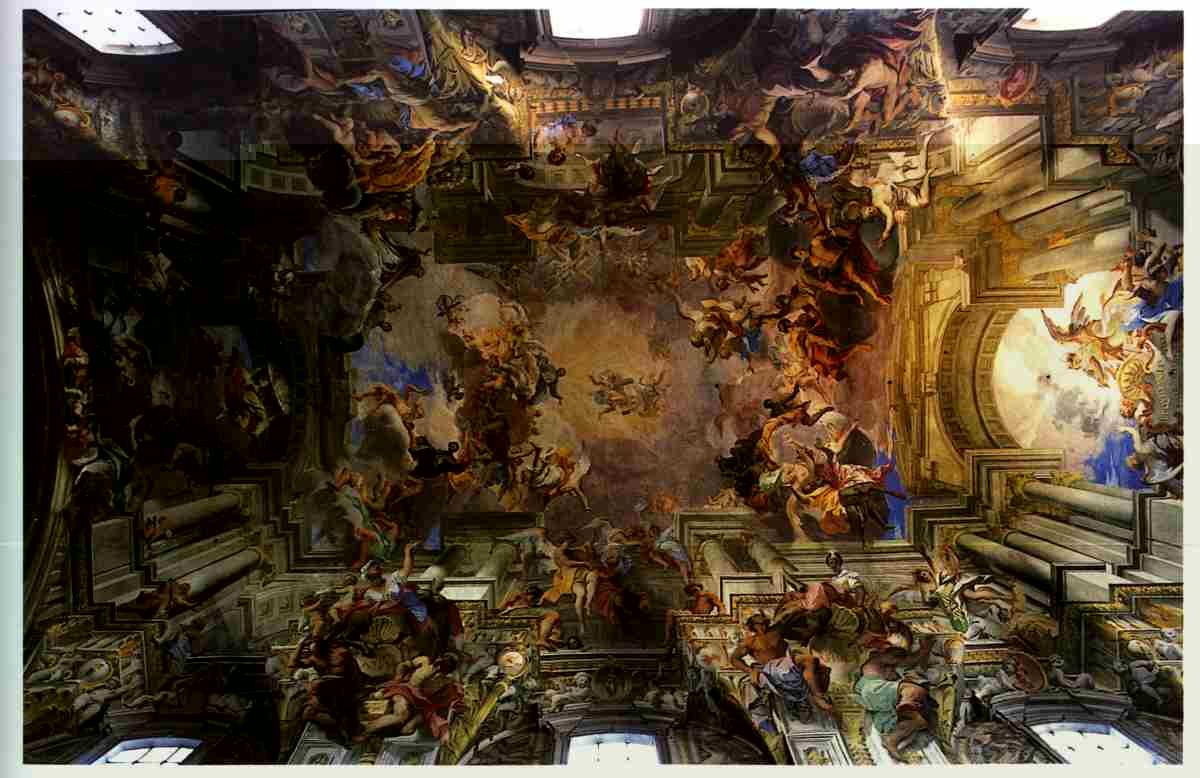
Ceiling of Sant’Ignazio Church (Roma) by Andrea Pozzo, 1691-1694
For a detailed discussion on why this perceptually differs from classical perspective paintings on canvas, see Michael Kubovy’s book The Psychology of Perspective and Renaissance Art. There is here again a precise point where everything is in order and takes sense. This point where the illusion is perfect might be the one where one understands the lure of representation and maybe the fragility of reality. In contemporary art, artists rather use simultaneous, fragmented, multiple viewpoints to show up the complexity of their discourse. An immediate example of this is Kosuth’s one and three hammers (1965) :
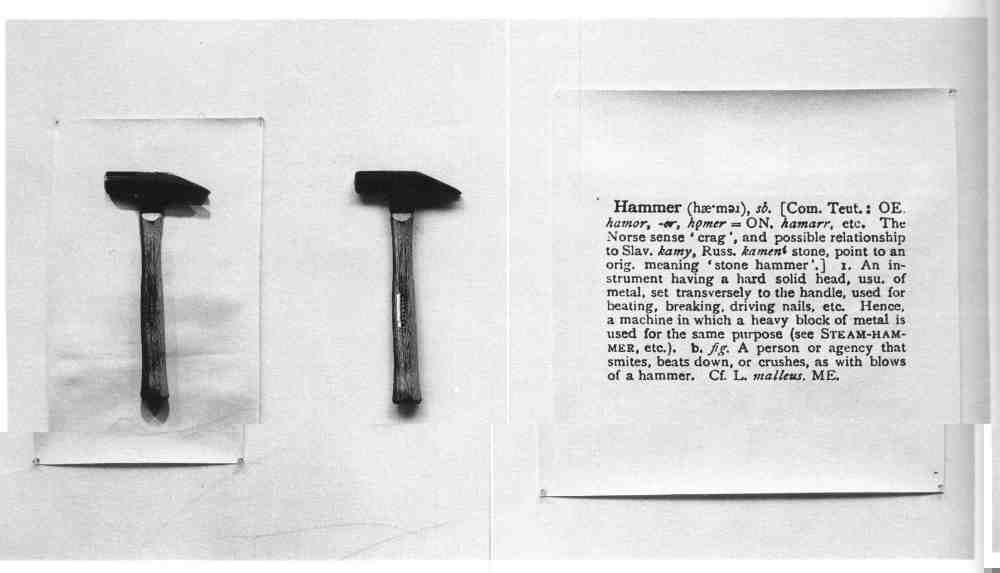
The simultaneous viewpoints on objects might be contradictory, to better ask the spectator on the ‘reality’ of the depicted object : for instance in Magritte’s Ceci n’est pas une pipe (1926).
IV. Interactivity, shared spaces and multi-user environments
Interactivity is indeed very limited in VE : in most of the so-called ‘interactive art’ only simple binary relations with objects (on/off) are usually implemented. That is, whenever the user moves to some point or touches an object, something happens. To take only two recent examples, the ‘serious games’ exhibition at the Barbican Gallery in London (1997) and the Exit Festival in Paris (1998) have shown that the involvement of the spectator in interactive artworks is quite limited, as his role is only to choose between a small number of possibility offered by the computer. There is only a limited and predefined dialogue between the spectator and the artwork.
A richer interaction would first require a real integration of the spectator in the artwork, which is not the case at present. In particular issues such as identity, self perception and the gaze of the Other are rather absent from VR works. There is some sort of schizophrenia between the real and the virtual world, whatever the complexity of the technical devices (HMD, datagloves, 3D sound) could ever be. We should nevertheless note that these questions are at the core of the contemporary reflection in art : one could mention the video works of Gary Hill or Bill Viola where the spectator is gazed at by many people on the video, or the omnipresent use of mirrors in paintings and/or installation art.
A new path to investigate for enlarging the degree of interactivity of new media artworks is the field of shared VE, where several users/spectators can enter the same digital space (through Internet connections for instance) and therefore start an interaction between their ‘avatars’, i.e. their incorporations in the virtual world. This technology is currently used as an infrastructure for creating digital communities and meeting spaces where people basically do nothing else than chatting. This could be seen as a 3D version of the textual MUDs (Multi-User Domains) of the early 90’s. Nothing prevents to use the same medium with a richer content in order to design complex interactions in artistic works. It possible to involve the spectator in a deeper way and to provide more complex experiences, such as including the user/spectator within the artwork itself. Indeed, virtual art spaces are fields of interactions, both between the artwork and viewers and between spectator themselves.
An example of this is the installation ‘resonance of 4’ by the Japanese artist Toshio Iwai :
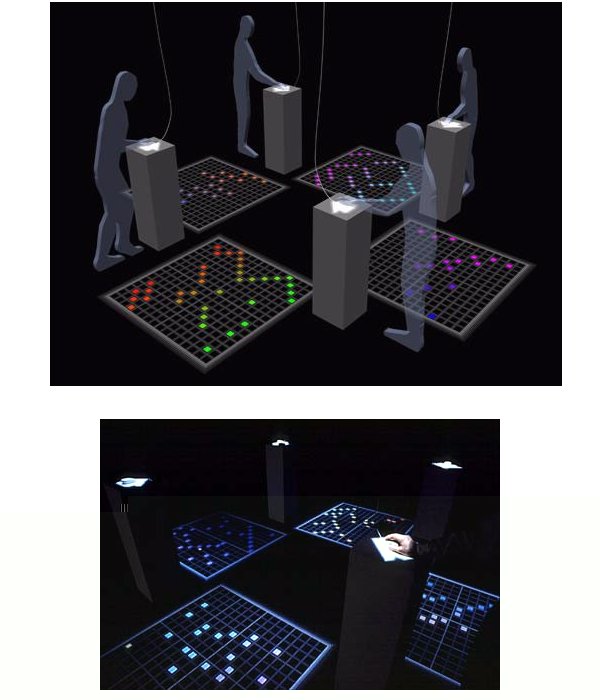
It is composed of 4 computer booths, to be used simultaneously by 4 spectators. Each person can produce some music, a simple melody entered in the computer with a grid-like device. But the overall point of this work is that spectators have to intuitively become aware that they are not alone in the installation but have to initiate some musical dialogue and co-operation to tune their melodies, whether in a consonant or dissonant way. Therefore the real signification of this artwork is the dynamics that can be created among spectators by using a simple interactive scheme such as music.
The core meaning of the artwork is thus an emergent behaviour between the spectators. The artist has to create a playfield and some adequate set of evolution rules in order to have this interaction to emerge. Meaning is thus not constructed by the artist and interpreted by the spectators, but fully and autonomously constructed by the spectators.
We therefore have to find new models and new concepts for thinking this complexity : self-organisation, emergent properties and autopoiesis, cf. the woks of F. Varela and U. Maturana.